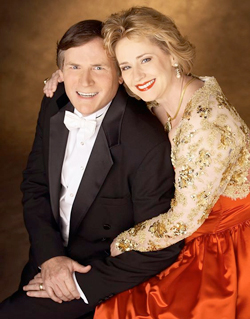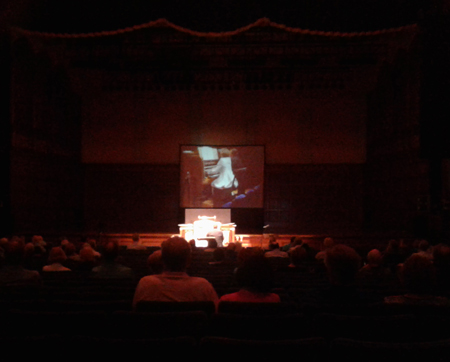by Daniel Hathaway

The Chenaults also share a church position, heading up the music at All Saints’ Episcopal Church in Atlanta, where they recently completed 40 years of service. Their recital on the Stambaugh Auditorium Organ Series in Youngstown on Sunday afternoon, September 18 included seven works written for and premiered by them.
The program, performed on Stambaugh’s restored E.M. Skinner instrument, got off to a thrilling start with the late Parisian organist-composer Gaston Litaize’s “Choral” from his Sonate à Deux, completed just before his death in 1992. A fantasia on the Gregorian Easter chant Victimae paschali laudes, the piece explored every tonal resource the Skinner had to offer, and that’s a lot.
A closed-circuit TV hookup allowed the audience a close-up view of the performers. It was riveting to watch the performers interact as hands, arms, and feet vied for position on the keyboards and pedalboards. The Skinner has four manuals to share, which perhaps made things a bit easier.
Bigger, more assertive pieces — York Minster organist Philip Moore’s Allegro (1993), Melinda Lee Clark’s “Tango” from An American Suite (2012), and the concluding work, former Gloucester Cathedral organist David Briggs’s Variations on ‘Veni Creator Spiritus’ (2007) alternated with more serene meditative pieces. The latter included Stephen Paulus’s “St. Anthony in Meditation” from The Triumph of the Saint (1994), Richard Shepard’s Eclogue (1991), Nicholas White’s Shenandoah (1993), and Gerre Hancock’s A Fancy For Two To Play (1987), which takes its title from a 17th century organ duet by Thomas Tomkins). All of these made use of colorful, more retiring stops of the organ.

Raymond and Elizabeth Chenault played with flawless technique and communicative energy throughout the program, but their most spectacular moments came in the Briggs variations that ended the concert. The composer’s seven variations on a Gregorian chant for Pentecost explore a range of techniques, textures and styles. Most stunning was the sixth, a “look, Ma, no hands” workout for four feet that the composer describes as “a neat alternative to going to the gym…and only to be played by organists who already know each other well (or perhaps hope to…)”
The only element that might have made this recital more effective had nothing to do with the playing. The decision (perhaps dictated by finances) to put the Skinner back into its pristine condition also left the instrument with only its five original presets. Modern, computer-driven combination actions allow performers to set up vastly more stop combination in advance. Having planned some 100 different registrations, the Chenaults were forced to make lengthy re-sets between each piece, which they managed by having Elizabeth set stops while Raymond spoke to the audience. That made Sunday’s recital almost half again as long as it should have been, as well as diminishing the forward thrust of the program.
The next Stambaugh Organ Series program brings Philadelphia’s Wanamaker Organ curator Peter Richard Conte to Youngstown on October 23 at 4:00 pm to improvise a score to the classic silent film Nosferatu.
Published on ClevelandClassical.com September 27, 2016.
Click here for a printable copy of this article



